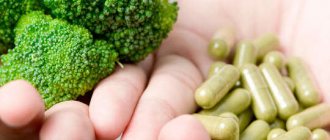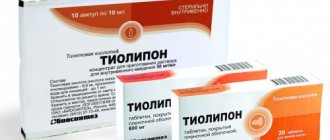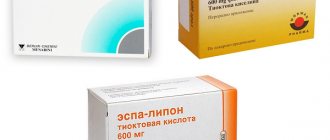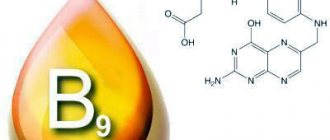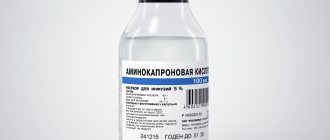Vitamin C is an important component of the diet of any person, regardless of gender and age. Since childhood, almost everyone has heard about the value of this substance for colds. Vitamin C not only helps to quickly get rid of annoying cold symptoms, but also helps the body avoid complications of infectious diseases.
Ascorbic acid is most relevant during the off-season, when environmental temperatures are unstable and the body experiences an acute shortage of vitamins and microelements. Despite this, a sufficient amount of ascorbic acid must be supplied to the human body, regardless of the time of year and circumstances.
Compound
The composition of the dragee includes ascorbic acid, starch syrup, sugar, talc, light mineral oil, yellow wax, dye E104 (quinoline yellow), orange flavor.
Composition of r/ra for IV and IM administration: ascorbic acid (0.05 g/ml or 0.1 g/ml), sodium bicarbonate and sulfite, water saturated with carbon dioxide for injection.
The tablets contain ascorbic acid, dextrose, sugar, potato starch, additive E470 (calcium stearate), flavoring (strawberry/raspberry/cranberry/wild berries).
Chewable tablets contain ascorbic acid, refined sugar, magnesium stearate, aspartame , microcrystalline cellulose, orange flavor, hypromellose, sunset yellow E110 or beta-carotene.
Release form
- Dragees, packaged in 50, 100 or 200 pcs. in bottles made of polymer materials/glass jars or 10 pieces in blister packs, 5 packs in a cardboard box.
- R/R for intravenous and intramuscular administration of 5 and 10% in ampoules of 1, 2 and 5 ml, 10 ampoules in a cardboard box.
- Lyophilisate for the preparation of solution for intravenous and intramuscular administration. Dosage 0.05 g. The drug is available in ampoules, 5 ampoules in a cardboard pack complete with solvent (water for 2 ml).
- Powder for the preparation of oral solution for oral administration. Dosage 1 and 2.5 g; sold in paper bags laminated with PE.
- Tablets, packaged in 50 pcs. in glass jars.
- Chewable tablets in package No. 30.
Pharmacodynamics and pharmacokinetics
The drug has the activity of vitamin C. It has a metabolic effect, regulates oxidation-reduction reactions and hydrogen transport in a large number of biochemical reactions, improves the use of glucose in the citrate cycle, accelerates tissue regeneration, takes part in the formation of H4-folate, collagen and steroid hormones .
Maintains normal permeability of capillary walls and the colloidal state of the extracellular matrix. Activates proteases, participates in the metabolism of cholesterol , pigments and aromatic amino acids, promotes the deposition of glycogen in the liver.
Due to the activation of liver cytochromes, it increases its protein-forming and detoxification activity, as well as the synthesis of prothrombin . Restores the endocrine function of the thyroid gland and the exocrine function of the pancreas , stimulates the secretion of bile .
Regulates immunological reactivity (activates the production of interferon , antibodies, components of the C3 complement system), promotes phagocytosis and strengthens the immune system .
It has an antiallergic effect and relieves inflammatory processes. Inhibits the production of mediators of anaphylaxis and inflammation (including prostaglandins ), inhibits the release of histamine and accelerates its degradation.
Since vitamin C is not produced in the human body, an insufficient amount of it in food provokes hypo- and vitamin C deficiency .
The daily norm for men is 0.07-0.1 g, for women - 0.08 g. During pregnancy, the need increases to 0.1 g, during lactation - up to 0.12 g. Children and adolescents, depending on age, should take from 0.03 to 0.07 g of vitamin C.
Absorbed in the small intestine: when taking less than 0.2 g, about 2/3 of the dose taken is absorbed; with increasing dose, absorption decreases to 50-20%.
The concentration of ascorbic acid when taken orally reaches a maximum after 4 hours.
The substance easily penetrates platelets and leukocytes , and subsequently into all tissues; deposited in the adrenal cortex, posterior lobe of the pituitary gland , intestinal walls, muscle tissue, brain, ovaries, interstitial cells of the seminal glands, ocular epithelium, spleen, liver, kidneys, lungs, pancreas and thyroid glands, heart.
Biotransformed mainly in the liver.
Ascorbate and its metabolites ( diketogulonic and oxaloacetic acids ) are excreted in urine and intestinal contents, and are also excreted in breast milk and sweat gland secretions.
Sources of Vitamin C
The body, due to its characteristics, does not accumulate ascorbic acid, so you should carefully monitor its consumption. The daily diet does not often contain foods rich in vitamin C. The amount of the substance should be replenished in medicinal form or in the form of nutritional supplements. The natural vitamin is water-soluble and easily subject to heat treatment, which destroys its beneficial chemical properties.
Main sources of the substance:
- kiwi;
- rose hip;
- Bell pepper;
- melon;
- black currant;
- onion;
- tomatoes;
- oranges;
- apples;
- peach;
- persimmon;
- Rowan;
- baked potato;
- cabbage;
- leafy herbs.
Previously, oranges and tangerines were considered the main fruits containing the most vitamins. Over time, scientists have proven that this is not so, but it is difficult to compare with rosehip, bell pepper and kiwi in terms of the presence of the substance.
Among animal products, vitamin C is found only in the liver, adrenal glands and kidneys.
Herbs containing ascorbic acid are added to any dishes during cooking:
- mint;
- nettle;
- oats;
- parsley;
- plantain;
- raspberry leaves;
- sorrel.
These plants are easily digestible, as evidenced by more than one table of nutritional value of products. People who adhere to a healthy diet do not have to worry about their vitamin levels, since their diet consists of healthy foods, the caloric content of which will not harm the diet.
There are no recommendations on how vitamin C is absorbed. To absorb as much ascorbic acid as possible, follow these rules:
- Vegetables and fruits are peeled and cut immediately before consumption.
- During cooking, vegetables are placed only in boiling water so that the organic vitamin does not dissolve in the water during heating.
- Cooked vegetables should not be left in the broth, because everything is given up to the liquid, and the fruits become useless.
- Fresh vegetable salads are salted and seasoned with sauces only before serving.
Vitamin C is consumed instantly after it enters the body; take care to consume the vitamin evenly throughout the day.
It is advisable to divide the daily dose into three equal portions, thus maintaining the concentration of the substance in the body constantly. Having found out what contains the most ascorbic acid, try to properly prepare and eat foods with an increased source of the substance.
Indications for use
The use of the drug is advisable for:
- hypovitaminosis C;
- capillarotoxicosis;
- hemorrhagic diathesis;
- hemorrhagic stroke;
- infectious diseases;
- bleeding (including nasal, uterine, pulmonary);
- idiopathic mehemoglobinemia;
- liver pathologies (including chronic hepatitis , Botkin's disease , cirrhosis );
- acute radiation sickness;
- complications of infusion-transfusion therapy;
- diseases of the digestive tract (including enteritis , colitis , peptic ulcer , achylia );
- Addison's disease ( hypocorticism );
- cholecystitis;
- parasitic diseases caused by helminths
- difficult-to-heal wounds, burns, fractures, ulcers;
- mental and physical overload;
- pregnancy;
- lactation;
- conditions that are accompanied by excessive deposition of hemosiderin ;
- erythro- and melasma ;
- psoriasis;
- chronic widespread dermatosis.
The antioxidant properties of ascorbic acid are used in the treatment of bronchial asthma , atherosclerosis , infectious and alcoholic delirium, diffuse connective tissue lesions (SLE, rheumatoid arthritis , scleroderma ), overdose of anticoagulants, intoxication with barbiturates, sulfonamides, benzene, aniline, methyl alcohol, anesthesin, carbon monoxide, dichloroethane, disulfiram, hydrocyanic acid, potassium permanganate, phenols, thallium, arsenic, quinine , aconite.
Taking the drug is also indicated during the recovery period after illnesses and surgical interventions.
Intravenous and intramuscular Ascorbic acid in ampoules is administered in situations where it is necessary to quickly compensate for vitamin C , as well as in situations where oral administration is impossible.
In particular, parenteral administration is required for Addison's disease , a number of gastrointestinal diseases (in conditions after resection of a section of the small intestine and gastrectomy , persistent diarrhea , peptic ulcer ).
Who should take ascorbic acid?
The benefits and harms of ascorbic acid depend on the specific disease. But, of course, it should be taken in conditions of immunodeficiency, after operations, injuries, physical and mental stress.
It facilitates the absorption of iron, keeping it in a reduced form, which is useful for anemia.
The mechanisms of action of ascorbic acid in the prevention and treatment of cancer include strengthening the immune system, stimulating collagen formation, and preventing metastasis.
The property of accelerating wound healing after surgery and faster healing of fractures was noted.
Contraindications
Absolute contraindications:
- hypersensitivity;
- venous diseases complicated by thrombosis and .
Conditions in which Ascorbic acid is prescribed with caution:
- diabetes;
- fructose intolerance;
- kidney pathologies (in particular, urolithiasis - when using more than 1 g per day);
- hemochromatosis;
- leukemia;
- thalassemia;
- progressive tumor diseases ;
- sideroblastic and sickle cell anemia ;
- polycythemia;
- deficiency of the cytosolic enzyme G6PD.
In pediatrics, the restriction on the use of Ascorbic acid tablets is the age of up to 4 years. Tablets are prescribed from the age of six. Chewable tablets are not used in pediatric practice.
Side effects
From the heart, vascular and hematopoietic systems: neutrophilic leukocytosis , thrombocytosis , erythropenia , hyperprothrombinemia .
From the sensory organs and nervous system: weakness and dizziness (with too rapid administration of ascorbic acid intravenously).
From the digestive tract: when taken orally - diarrhea (when taking more than 1 g/day), irritation of the mucous membrane of the digestive canal, accompanied by nausea, diarrhea , vomiting, erosion of tooth enamel (with frequent use of chewing tablets or dissolving pills/tablets).
Metabolic disorders: disruption of metabolic processes, inhibition of glycogen , excessive formation of adrenergic steroids , water and Na retention, hypokalemia .
From the urogenital tract: increased diuresis , formation of oxalate stones (especially with long-term intake of more than 1 g per day), damage to the glomerular apparatus of the kidneys .
When injected into a muscle, pain at the injection site may occur; injection into a vein may be accompanied by a feeling of heat.
The substance is a strong allergen and can provoke hypersensitivity reactions even in cases where the person does not exceed the recommended daily dose.
Symptoms of an allergy to ascorbic acid manifest themselves in the form of skin hyperemia and the appearance of a skin rash.
Instructions for use of Ascorbic acid
How to take oral forms of Ascorbic acid?
Dragees and tablets are recommended to be taken after meals. Chewable tablets should be chewed and washed down with a small amount of drinking water before swallowing.
Ascorbic acid powder is used to make drinks. To do this, 1 g of the product (about ⅓ teaspoon) is diluted in a liter of water or juice.
For preventive purposes, adults are advised to take from 0.05 to 0.1 g/day, the daily dose for a child varies from 0.025 to 0.075 g. Pregnant and lactating women should take 0.3 g/day in the first 10-15 days day, then the dose is reduced to 0.1 g/day.
For therapeutic purposes, adults, depending on the indications, are prescribed to take from 0.15 to 0.5 g/day. (dosage depends on indications). The daily dose is divided into 3-5 doses. For children, the daily dose is from 0.1 to 0.3 g. It should be divided into 2-3 doses. The duration of the course is 14 days.
The therapeutic dose of Ascorbic acid in the form of chewable tablets is 0.25 g/day. Treatment lasts from 10 to 15 days. For influenza , severe colds, vitamin deficiency and infectious diseases, the daily dose is increased by 2-4 times. Taking vitamin C in a higher dose is allowed for 7 to 10 days.
Instructions for Ascorbic acid in ampoules
IV ascorbic acid is administered in a stream or drip. The dose is selected individually depending on the nature and severity of the disease. For patients over 12 years of age, it varies from 0.05 to 0.15 g. In case of poisoning, the dosage can be increased to 3 g.
For children under 12 years of age, a single dose is 5-7 mg/kg.
The duration of treatment is determined by the nature of the pathological process and the effectiveness of therapy.
The highest single dose for an adult is 0.2 g, the daily dose is 1 g. For children, the dosage is selected depending on age. As a rule, the daily dose is:
- up to six months - 0.03 g;
- 6-12 months - 0.035 g;
- 12 months-3 years - 0.04 g;
- 4-10 years - 0.045 g;
- 11-12 years old - 0.05 g.
The highest daily dose for a child under 12 years of age is 0.1 g.
The solution is injected in a stream over 1-3 minutes. The drug is administered dropwise slowly by intravenous infusion, having previously dissolved a single dose in 50-100 ml of 0.9% NaCl solution. The rate of administration is 30-40 drops per minute.
Intramuscular Ascorbic acid is injected deep into the muscle.
Ascorbic acid with glucose
Ascorbic acid with glucose is prescribed for the prevention and treatment of infectious diseases in weakened patients.
The prophylactic dose for an adult is 0.5-1 tablets/day, the therapeutic dose is from 1.5 to 5 tablets/day. For children over 5-6 years old, the prophylactic dose is 0.5 tablets/day. therapeutic - 1-3 tablets/day.
Glucose with ascorbic acid is prescribed intravenously for the prevention of secondary infection, pulmonary edema , renal and hepatic failure and a number of other pathologies. The benefits of this remedy are also enormous for pregnant women who suffer from severe toxicosis and need additional support for the body. In each specific case, the dose is selected individually.
Reviews indicate that many people (especially people on a diet) use ascorbic acid tablets with glucose instead of prohibited sweets, believing that they are less harmful. The calorie content of glucose is 340 kcal, and one tablet contains 877 mg. That is, 1 tablet is approximately 30 kcal.
However, using the drug instead of sweets and regularly exceeding the daily requirement of vitamin C is fraught with serious stomach problems.
Application in cosmetology
Ascorbic acid, as an antioxidant, is included in anti-aging cosmetics for women. Products based on vitamin C prevent the effects of free radicals on the skin of the face, which is why it is used in the manufacture of anti-aging creams.
The presence of a vitamin in the list of cosmetic ingredients does not guarantee quality, since the amount of the element used is not always enough to produce an effect. The optimal dose in cosmetology ranges from 0.3% to 10%. Professional preparations on the labels contain information about the amount of active substance and the percentage of components.
Due to the sensitivity of the vitamin to light and air, cosmetics based on it are produced in sealed, tinted packaging with a dispenser.
Vitamin C-based facial cosmetics perform the following functions:
- protect the skin from exposure to infrared rays;
- synthesize collagen;
- restore collagen fibers;
- slow down the aging process;
- increase skin tone;
- prevent the appearance of age spots;
- relieve inflammation;
- refresh and improve complexion;
- strengthen vascular walls.
Best materials of the month
- Coronaviruses: SARS-CoV-2 (COVID-19)
- Antibiotics for the prevention and treatment of COVID-19: how effective are they?
- The most common "office" diseases
- Does vodka kill coronavirus?
- How to stay alive on our roads?
In winter, to replenish vitamin C reserves, it is necessary to take vitamin and mineral complexes for the skin.
Ascorbic acid is useful for hair; it gives hair shine and silkiness. Liquid vitamin C in ampoules is added to ordinary shampoo or hair conditioner. Nutrition along the entire length is provided during each wash.
Overdose
An overdose of Ascorbic acid develops with prolonged use of doses exceeding 1 gram per day. Its signs are:
- headache;
- nausea;
- insomnia;
- increased excitability of the central nervous system;
- ulceration of the mucous membrane of the digestive canal;
- vomit;
- diarrhea;
- inhibition of the functional activity of the pancreas insular apparatus;
- nephrolithiasis;
- oxalosis;
- hyperacid gastritis;
- moderate pollakiuria;
- damage to the glomerular (glomerular) apparatus of the kidneys;
- decreased permeability of capillary walls.
In some cases, blood pressure and blood clotting increase, tissue trophism worsens, and microangiopathies .
Intravenous administration of high doses of vitamin C can provoke erythrocytolysis and abortion.
The lethal dose of vitamin C is 20-30 grams.
Interaction
Ascorbic acid (A.A.) increases the plasma concentration of salicylates , ethinyl estradiol , tetracycline antibiotics , benzylpenicillin ; reduces - oral contraceptives
Absorption and assimilation of A.K. is disrupted by gastrointestinal pathologies ( diarrhea/constipation , peptic ulcer , gastritis , giardiasis , helminthic infestation ), taking the drug with alkaline drinks, as well as with fresh juices from fruits and vegetables, in combination with oral contraceptives and acetylsalicylic acid .
A.k. increases the activity of norepinephrine , reduces the effectiveness of heparin and coumarin anticoagulants , improves the absorption of iron preparations in the intestinal tract.
In combination with deferoxamine, it can provoke an increase in tissue toxicity of iron (including cardiotoxicity ) and lead to the development of heart failure .
Increases the total plasmatic clearance of ethyl alcohol. Affects the effectiveness of disulfiram .
Vitamin C reserves are depleted with long-term use of calcium chloride, quinoline , salicylates , and corticosteroids .
Solution A.K. interacts with most medications when mixed in one syringe.
Story
Vitamin C gets its name from the Latin word “scorbutus”, which means “scurvy”. It was with the advent of this disease that the world first learned about vitamin C.
In ancient times, sailors who were on long voyages often suffered from scurvy.
This is a disease in which teeth begin to crumble and gums bleed, general weakness, rashes and hemorrhages appear on the skin.
The disease was often fatal.
However, thanks to the Indians , salvation was found. Following their example, the sailors drank a decoction of pine needles, which contained vitamin C in huge quantities.
This made it possible to significantly reduce mortality from scurvy. Back in the 18th century, British navy surgeon J. Lind proved that sailors' illness could be cured by eating more fresh fruits and vegetables.
Reference! The American biochemist Albert von Szent-Gyorgy is considered the discoverer of vitamin C. He was the first to succeed in isolating ascorbic acid from the adrenal glands of pigs. And he extracted vitamin C in large quantities from sweet peppers.
In 1933, Dr. Tadeusz Reichstein synthesized ascorbic acid and proved that it was identical to natural vitamin C. This achievement was the first step towards industrial production of the vitamin, which began in 1936.
Today, vitamin C is one of the most important elements of immunopharmacology . Scientists around the world are researching the direct effects of the vitamin on various forms of cancer, and have already achieved some results.
special instructions
Wikipedia states that vitamin C (L-ascorbic acid) is an organic compound related to glucose. Its benefits for the human body are enormous - the vitamin functions as a coenzyme for a number of metabolic processes, an antioxidant and a reducing agent.
Structural formula of ascorbic acid:
According to the International Pharmacopoeia, the substance has the form of an almost white or white crystalline powder with a sour taste. Easily soluble in water, soluble in ethanol (approximately 750 g/l) TS, practically insoluble in other organic solvents, the powder is practically insoluble. Belongs to the category of antiscorbutic drugs.
Vitamin C in solution is quickly destroyed by exposure to air; Even in a light-protected place, it gradually collapses in a humid atmosphere. The rate of destruction increases with increasing temperature.
Ascorbic acid is present in all tissues of higher plants and animals. Man, unlike most animals, in the process of evolution, due to mutation, has lost the ability to independently synthesize vitamin C , and receives it exclusively from food.
OKPD code for ascorbic acid ( vitamin C ) is 24.41.51.180. For the food industry, the substance is obtained in accordance with GOST 4815-76.
Quantitative determination of a substance
Methods for quantitative determination of A.c. based on its pronounced restorative properties.
The simplest, objective and accurate method is the determination method based on the ability of A.K. reduce ferric ions into ferrous ions.
The amount of Fe2+ ions formed is equimolar to the amount of A.c. in the analyzed sample (the minimum amount of A.C. in the sample is 10 nmol) and is determined by the color reaction with potassium iron sulfide.
What is ascorbic acid needed for?
The substance is involved in the processes of biotransformation of other vitamins , the formation of collagen , as well as the formation and exchange adrenaline and norepinephrine adrenal medulla , supplies hydrogen for the formation of nuclear DNA, reduces the body's need for B vitamins , increases the body's immunobiological resistance, affects the activity of leukocytes ; improving the absorption of Fe, thereby enhancing the synthesis of hemoglobin and the maturation of red blood cells , neutralizes toxins released by pathogenic microflora, accelerates the healing of wounds and postoperative sutures and the healing of fractures.
Ascorbic acid in urine is an important indicator of the health of the body. A small amount of vitamin C in urine may indicate problems with internal organs or the development of a tumor process. Elevated concentrations of ascorbic acid may indicate an unbalanced diet and the likelihood of kidney stones.
The daily rate of excretion of vitamin C in urine is 0.03 g. When diagnosing this indicator, we can conclude that a person receives a sufficient amount of ascorbic acid, and his body works optimally.
How many calories are in ascorbic acid?
100 grams of product contains 0.1 g of fat, 0.1 g of protein and 95.78 g of carbohydrates. This amount of carbohydrates allows you to compensate for more than a third (namely 35%*) of your daily requirement for them.
*The average nutritional value of products from different sources is given. Data may vary depending on the origin of the product. The value is given for a diet that involves consuming 2 thousand kcal per day.
Calorie content of 100 grams of product is 970 kJ or 231.73 kcal.
Why is ascorbic acid useful in cosmetology?
In cosmetology, ascorbic acid is used in preparations that slow down aging, restore protective functions and accelerate healing.
The easiest way to use vitamin C for hair is to add powder (crushed tablet) or solution to a single serving of shampoo or hair mask. Ascorbic acid should be added to care products immediately before use.
Such simple procedures can restore hair structure, prevent hair loss, and make hair soft and shiny.
For the face, ascorbic acid is most often used in powder. Before the procedure, the powder (or crushed tablets) is mixed with mineral water to form a thick paste. The product is applied to the face for 20 minutes and then washed off.
Daily rubbing with a solution of ascorbic acid diluted with mineral water in a 1:1 ratio is also beneficial for the face. You can also add the solution/powder to homemade masks.
How is ascorbic acid beneficial for athletes?
Vitamin C is a stimulator of muscle mass anabolism, which makes its use in bodybuilding appropriate. In addition, scientists were able to prove that by suppressing the process of peroxidation and cortisol , it also has an anti-catabolic effect . Thus, taking vitamin C before exercise will protect your muscles and slow down protein breakdown.
Upon completion of a course of anabolic steroids, ascorbic acid is taken as a component of PCT (post-cycle therapy).
Ascorbic acid to induce menstruation
High doses of vitamin C prevent the entry of progesterone into the uterus, so ascorbic acid is often taken when menstruation is late.
However, doctors do not advise abusing this method. Firstly, repeated use of ascorbic acid can cause problems with the gastrointestinal tract. Secondly, taking pills can make it difficult to diagnose the causes of menstrual irregularities and further treatment.
Precautionary measures
Too rapid intravenous administration of ascorbic acid solution should be avoided. If long-term use of the drug is necessary, monitoring of blood pressure, renal function, and glucose levels is necessary.
Ascorbic acid alters laboratory test results.
Functions in the body
The main role of ascorbic acid in the human body is the fight against radicals and antioxidant effect. It is also a powerful antioxidant, as it protects internal organs and tissues from possible damage and the development of cancer.
What is vitamin C for? With its participation, redox processes occur in the body, protein synthesis occurs, and connective tissues are strengthened. Vitamin C accelerates the healing of wounds and scars and has a positive effect on epithelial regeneration.
It is important for athletes to regularly take vitamin and mineral complexes containing ascorbic acid, since it normalizes energy processes and increases endurance. The synthesis of steroid hormones, the metabolism of folic acid, and some metals cannot do without vitamin C. In bodybuilding, the substance is valued for its role in gaining muscle mass, since the level of absorption and processing of protein depends on it.
The importance of ascorbic acid for the body cannot be overestimated. Vitamin C strengthens blood vessels and promotes better permeability of important elements through their walls. If vitamin C is present in the body in the right amount, inflammatory processes occur in a lighter form.
The absorption of iron thanks to vitamin C improves, and the blood is provided with an antianemic factor.
The immune system works at full strength in the presence of three main vitamins: A, C, E. Ascorbic acid is responsible for the functionality of protective cells; if there is enough of it, the immune system resists any foreign agents: viruses, bacteria, parasites.
Oncology is considered the plague of the 21st century; statistics show that the number of cancer cases is steadily growing. Oncologists say that with normal levels of vitamin C in the body, a natural fight against cancer cells occurs. However, if a surplus of ascorbate forms in the body, mutating cancer cells become more resistant, even radiation therapy does not kill them. Cancer patients are advised to maintain vitamin C at the proper level.
Ascorbic acid protects the liver from the effects of toxins, removes copper, radioactive substances, mercury, and lead. To prevent the development of diseases of the gastrointestinal tract, ascorbate has become an indispensable remedy. By controlling the level of the substance in the body, there is a chance to avoid cancer in the colon and bladder.
Acid normalizes the functionality of the nervous system, the body gains resistance to stress, and the strength to resist pathogens appears. In addition, the work of the adrenal glands is balanced and the required amount of hormones responsible for combating stress is produced. This is not all that ascorbic acid is responsible for.
It is impossible to give an objective assessment of the effect of vitamin C. In the twenty-first century, science does not know all the properties that a substance has. Do not underestimate control over the level of ascorbic acid in the body, since its deficiency causes the development of chronic diseases.
For weight loss
Ascorbic acid does not reduce the amount of subcutaneous fat and cannot eliminate the consequences of an unbalanced diet and inactive lifestyle, so using it as an independent means for losing weight is not advisable.
However, vitamin C is by no means an unnecessary addition to the diet of those losing weight, because it helps strengthen the immune system, improve overall well-being in chronic diseases and more quickly restore muscles after physical activity.
Introduction
The fact that even children know that vitamins are good for health does not need confirmation for a long time.
Vitamins help maintain the normal functioning of all systems of the human body, and a deficiency of at least one of them leads to serious diseases.
“Ascorbic acid”, familiar to everyone since childhood, has a huge amount of useful substances.
A powerful antioxidant , vitamin C prevents the occurrence of colds, improves skin condition, heals wounds, lowers cholesterol and takes care of the heart.
Can pregnant women take ascorbic acid?
The minimum requirement for ascorbic acid during pregnancy is approximately 0.06 g/day. (in the 2nd and 3rd trimesters). It is important to consider that the fetus can adapt to increased doses of vitamin C . The consequence of this may be withdrawal syndrome in the newborn.
In accordance with the FDA classification, injectable forms of ascorbic acid belong to group C on the scale of possible risks to the fetus. The administration of the solution can be prescribed to a pregnant woman only if absolutely necessary.
The use of high doses intravenous vitamin C
The minimum requirement during breastfeeding is 0.08 g/day. Theoretically, there are certain risks for the child when a nursing woman uses too high doses of vitamin C.
How to avoid
Doctors do not recommend using the drug in the morning on an empty stomach, as this increases the risk of stone formation. Patients with high blood pressure should monitor their health and regularly measure their blood pressure. And we must also not forget that acid significantly increases the rate of iron absorption and can harm all those patients whose level of this microelement is already quite high. In this case, it is advisable to consult with your doctor, who will prescribe appropriate treatment and advise other ways to take ascorbic acid.
Reviews about Ascorbic acid
It is impossible to find negative reviews about ascorbic acid. Ascorbic acid is a tasty and healthy medicine that helps alleviate the symptoms of the acute period of infectious diseases and improve the body’s condition in chronic pathologies. It is used as an independent remedy or in combination with other vitamins or with glucose .
Everyone probably knows about the benefits of vitamin C. However, reviews about it also mention little-known properties of ascorbic acid, for example, its ability to induce menstruation. Some women claim that it was thanks to taking ascorbic acid that they were able to regulate their cycle without the use of hormones.
The scheme for using Ascorbic acid to normalize menstruation is simple: count 10 days from the last day of menstrual bleeding and take 1 gram of vitamin C daily from 11 to 20.
Compatibility
With alcohol
Alcohol and vitamin C are completely incompatible .
However, it is often used in the treatment of alcoholism as a means of prevention.
Alcohol has a harmful effect on the body.
First of all, the immune system suffers, it becomes weaker and the person gets sick more often.
Ascorbic acid, as a powerful antioxidant , removes alcohol from the body and protects the liver from its effects.
With retinol
Retinol (vitamin A) is combined with vitamin C. Together with vitamin E, they protect retinol from oxidation.
There is an opinion that vitamins A and C neutralize each other, however, this is a misconception. It has been proven that retinol and vitamin C are completely compatible.
With vitamin E
Vitamin C enhances the effect of vitamin E.
Both vitamins are excellent at cleansing the body of antioxidants, reducing inflammation and protecting cells from damage.
With zinc
Zinc and vitamin C are not only compatible , but also enhance each other’s effects.
It is recommended to take these vitamins together to prevent colds, as they help the human immune system fight viruses.
With iron
Vitamin C is compatible with iron supplements. Together with vitamin A, they increase its bioavailability.
In addition, due to vitamin C, iron is better absorbed and does not cause irritation to the gastrointestinal mucosa.
Ascorbic acid price, where to buy
The average price of Ascorbic acid in 2 ml ampoules (package No. 10) is 39 rubles/20 UAH. The price of tablets varies depending on the concentration of the active substance and the number of tablets/dragés in the package. You can buy 0.025 g tablets (package No. 10) in Ukrainian pharmacies for 3 UAH, in Russian pharmacies for 7 rubles.
- Online pharmacies in RussiaRussia
- Online pharmacies in UkraineUkraine
- Online pharmacies in KazakhstanKazakhstan
ZdravCity
- Be-be-bears Ascorbic acid with raspberry flavor 770 mg 10 pcs. VTF LLC
35 rub. order - Ascorbic acid with sugar, raspberry flavor tab. 25 mg No. 10 (budget)Askoprom LLC RU
9 RUR order
- ASCORBINKA ascorbic acid with raspberry flavor powder in bags 500 mg 30 pcs ZDRAVSITINPTS EcoFarm LLC
RUB 192 order
- Ascorbic acid, etc. 50 mg 200 pcs. JSC Ufimsky Vitam.Z-D
26 RUR order
- Ascorbic acid with glucose tablets 20 pcs. AO Update PFC
47 RUR order
Pharmacy Dialogue
- Ascorbic acid with sugar (twist No. 10) Square C
30 rub. order
- Ascorbic acid (port. 2.5 g (raspberry))Ascoprom
5 RUR order
- Ascorbic acid (other No. 200) Uralbiopharm
25 rub. order
- Ascorbic acid (por. 2.5 g (lemon))Ascoprom
5 RUR order
- Ascorbic acid tablets No. 10 with glucose Meligen FP ZAO
10 rub. order
show more
Pharmacy24
- Ascorbic acid 0.05g No. 50 dragee PAT "Kiev Vitamin Plant", Kiev, Ukraine
6 UAH. order - Ascorbic acid 0.025g N10 mint tablets PAT "Kiev Vitamin Plant", Kiev, Ukraine
5 UAH order
- Ascorbic acid 50 mg N50 chewable tablets PAT "Lubnifarm", Ukraine
8 UAH order
- Ascorbic acid glucose 0.1g No. 10 tablets PAT "Kiev Vitamin Plant", Kiev, Ukraine
4 UAH order
- Ascorbic acid lemon 0.025 g No. 10 tablets PAT "Kiev Vitamin Plant", Kiev, Ukraine
5 UAH order
PaniPharmacy
- Ascorbic acid solution d/in.50 mg/ml amp.2ml No. 10 Ukraine, Lekhim-Kharkov JSC
19 UAH order
- Ascorbic acid solution d/in.100 mg/ml amp.2ml No. 10 Ukraine, Lekhim-Kharkov JSC
25 UAH order
show more




